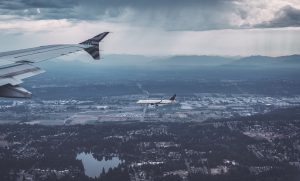 Airplanes have revolutionized the way in which we travel. At any given time, statistics show there are roughly 5,000 commercial airplanes in the air. While some of these flights are short, connecting two or more cities within the same country, others are intercontinental. Regardless of route distance, though, there are four key forces acting upon airplanes in the air, each of which affects an airplane’s ability to fly. So, what are the four forces of flight exactly?
Airplanes have revolutionized the way in which we travel. At any given time, statistics show there are roughly 5,000 commercial airplanes in the air. While some of these flights are short, connecting two or more cities within the same country, others are intercontinental. Regardless of route distance, though, there are four key forces acting upon airplanes in the air, each of which affects an airplane’s ability to fly. So, what are the four forces of flight exactly?
#1) Gravity
Gravity is the invisible force created by Earth that pulls objects, including airplanes, down. All forms of matter produce a gravitational field, though the strength of this field is relative to the object’s mass. The gravitational field produced by Earth pulls objects downwards at a speed of 9.807 m/s². Therefore, aerospace manufacturing companies must factor the force of gravity into their airplanes’ designs.
#2) Thrust
Thrust is the force produced by an airplane that moves it forwards. Airplanes typically produce thrust in one of two ways: jet engines or propeller engines. Propeller engines have one or more propellers that rotate to produce thrust, whereas jets burn fuel to produce thrust. Of those two methods, jet engines create significantly more thrust than their propeller counterparts, which is why so many commercial airplanes feature them. Regardless, all airplanes must produce thrust. Otherwise, they won’t be able to move forward.
#3) Drag
Drag is the force acting against an object in motion. When an airplane moves forward (thanks to thrust), drag works against it to slow it down. According to NASA, flight-related drag is created in one of two ways: friction and air pressure differences. During flight, an airplane’s body will “rub” against the air, thus creating friction and drag. Furthermore, differences in air pressure can create drag that slows down an airplane.
#4) Lift
Finally, lift is the force that keeps an airplane in the air, preventing it from falling to the ground below. It’s created primarily by an airplane’s wings. The wings create lift that holds the airplane in the air. Lift can best be described as an aerodynamic force that’s created when an object or airplane moves through the air.
To recap, the four forces of flight consist of gravity, thrust, drag and lift. Gravity is the force by produced by Earth that pulls airplanes down; thrust is the force that moves airplanes forwards; drag is the force that acts against airplanes in motion; and lift is the force that keeps airplanes in the air.



